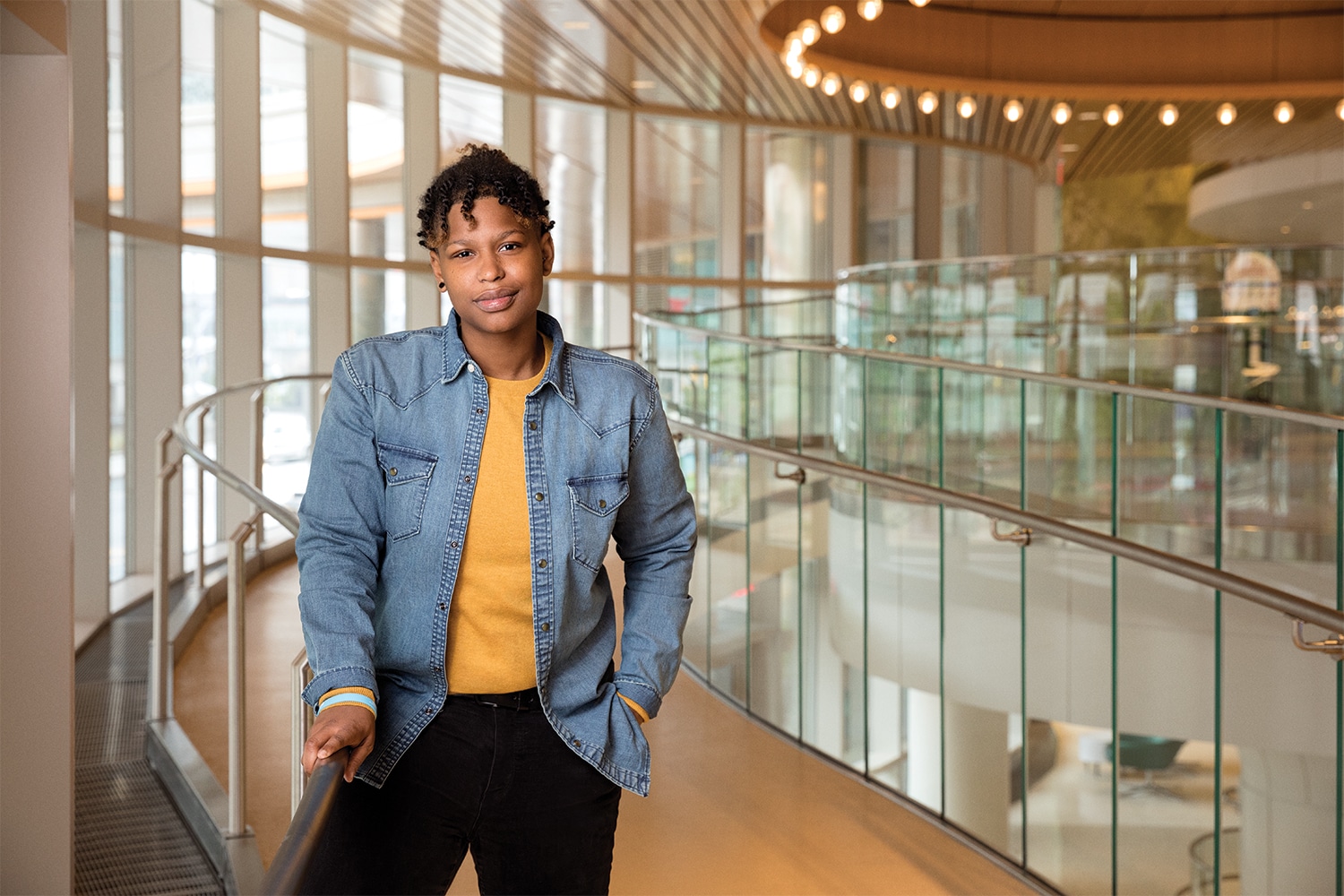ON THANKSGIVING DAY 2011, Court Simmons threw on a pair of shorts and jogged toward the hospice center where her mother, Crystal, was a patient. The energetic 16-year-old loved to cook and had just finished making turkey dinner for her favorite person—her little brother, Reginald, who was 14. As Court (short for Courtney) ran down the street toward the hospice center, a few blocks away from her Philadelphia home, a throbbing ache beneath her left kneecap forced her to slow her pace to a walk. “I was dealing with a lot, so I ignored the pain. It seemed like the right thing to do at the time,” she says.
Since Court was 9 years old, she had watched her mom, a single parent, deal with a soft tissue sarcoma, a type of cancer that develops in tissue such as muscle or fat. The experience forced Court to grow up fast. When she was 12, her older sister, Christina, who was 17 at the time, died of a brain tumor. And Court was just 16 when her mother died on Christmas Day 2011, at the age of 41.
After her mother’s funeral in January 2012, Court couldn’t wait to get back to school. She and Reginald were staying temporarily with her mother’s friend because they had no legal guardian at the time. School was a refuge—she enjoyed class time, loved reading and longed to laugh with her friends.
On her first day back, Court chased her best friend down the hallway near their lockers. A terrible pain shot up her left leg, similar to what had happened when she ran to her mother’s hospice center on Thanksgiving Day. She sat down on the floor as her leg throbbed, rolled up her pants leg and saw the skin had turned purple. “I thought maybe I had torn a muscle,” she says.
A few days later, she found herself sitting in a dark room at Children’s Hospital of Philadelphia (CHOP) staring in disbelief at an MRI image of an orange-sized mass protruding from the top of her left shin. A biopsy confirmed that she had osteosarcoma, a form of bone cancer. “The universe wouldn’t do this,” she thought to herself.
A Family History
To say cancer runs in Simmons’ family is an understatement. Court, her mother and her sister all were diagnosed with a condition called Li-Fraumeni syndrome, a rare genetic disorder that predisposes children and adults to several kinds of cancer. (Reginald does not have Li-Fraumeni.) “People with Li-Fraumeni syndrome are born with a mutation in a tumor-suppressing gene or oncogene that predisposes them to certain types of cancer,” says pediatric oncologist Abby Green of CHOP, who treated Court. Cancer striking two young people in one family is a major red flag suggesting Li-Fraumeni syndrome, Green says. In the Simmons family, cancer had hit three family members when they were young: Court’s mom was diagnosed with breast cancer at age 18, while pregnant with Christina, and with soft tissue sarcoma in her mid-30s.
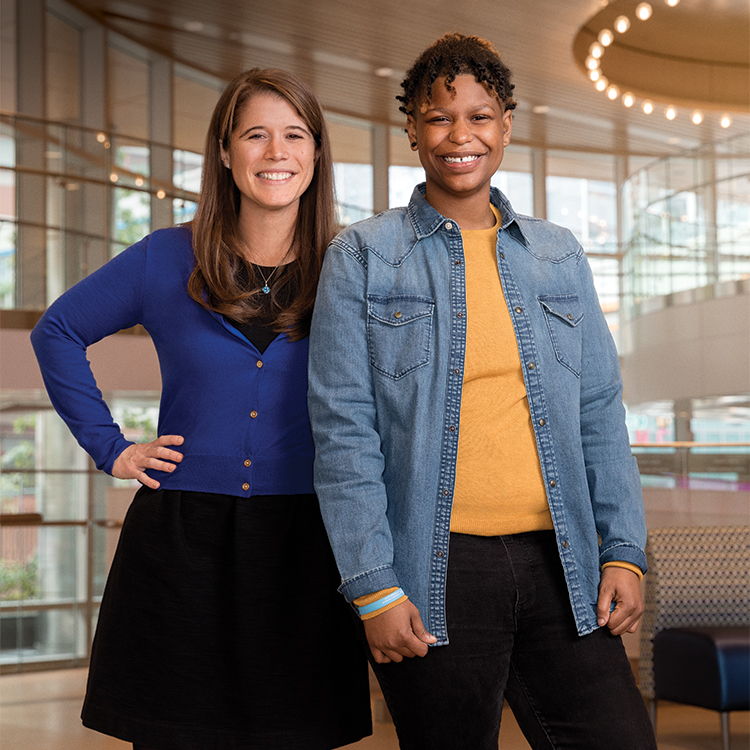
Court Simmons, right, stands with her pediatric oncologist, Abby Green, at Children’s Hospital of Philadelphia. Photo by Colin M. Lenton
Court is one of about 1,000 people in the United States who are diagnosed each year with osteosarcoma, a type of cancer associated with Li-Fraumeni syndrome. Close to half of those diagnosed with osteosarcoma are children and young adults. The disease tends to develop in the rapidly growing long bones of the legs and arms, especially in teens hitting their growth spurt.
In Court’s case, the cancer had not yet spread beyond her leg bone, and the tumor was in a good location for removal. Her prognosis was favorable, says Green, “but we knew it wouldn’t be easy for her.” She would require 30 weeks of chemotherapy, reconstructive surgery on her leg and rehabilitation to strengthen her leg muscles.
Court’s first chemotherapy treatment was rough. She suffered severe nausea and vomiting. “It was so intense, I wanted to die,” she remembers. During this time, while visiting his sister at the hospital, Reginald asked matter-of-factly, “Hey Court, are you going to die, too?”
“That moment was like a switch went off,” Court says. “I decided I would do everything I could to make sure my brother wouldn’t be alone.”
Over the next several months, Court bounced back and forth between the homes of two of her mother’s friends and CHOP, where she received chemotherapy to shrink her tumor.
After three months, the tumor was small enough for doctors to remove. On April 10, 2012, she had surgery on her leg. The tumor on the head of her tibia was close to the knee, so the surgeon removed the top of her tibia, the entire knee joint and part of her femur. Court woke up from surgery with a total knee replacement and a titanium femur prosthesis.
Roughly 50 percent of people with Li-Fraumeni syndrome develop cancer before age 40.
Li-Fraumeni syndrome is a genetic predisposition to several cancers, including soft tissue sarcoma, osteosarcoma, breast cancer, brain and central nervous system tumors, acute leukemia and adrenocortical carcinoma. It typically runs in families. Physicians and researchers Frederick Li and Joseph Fraumeni first reported the disorder in 1969. It’s not clear exactly how many people are affected by Li-Fraumeni syndrome, but it is extremely rare.
Most people with Li-Fraumeni syndrome have a mutation in a tumor-suppressing gene known as TP53. “TP53 is sort of like the guardian of the genome,” says pediatric oncologist Abby Green of Children’s Hospital of Philadelphia. It signals cells that contain mutated DNA to “commit suicide” in order to prevent cancerous tumors from developing. In people with a defective TP53 gene, mutations can accumulate and tumors develop unchecked. The disease is diagnosed with a blood test for the gene mutation.
Roughly 50 percent of people with Li-Fraumeni syndrome develop cancer before age 40. Many develop two or more cancers in their lifetime. “Right now, research and care is focused on how to best screen for cancers in genetically predisposed kids and treat them early,” says Green. An ongoing screening study at the National Cancer Institute is investigating the efficacy of whole-body MRI scanning for the detection of cancers associated with Li-Fraumeni syndrome.
Finding Support
The most excruciating part of treatment came next—rehabbing after surgery. “Courtney had so much motivation. She pushed through in an incredible way,” says Green.
Court was used to taking care of herself at home, so it was hard to accept help from others for simple tasks like putting on socks or taking a shower. She began to set small goals for herself, focusing first on standing, then shuffling a few feet on crutches to use the commode. “I got so excited the first time I didn’t have to call anyone to help me go to the bathroom,” she says. When she had trouble sleeping, she would spend long hours walking the hallways of CHOP to strengthen her leg.
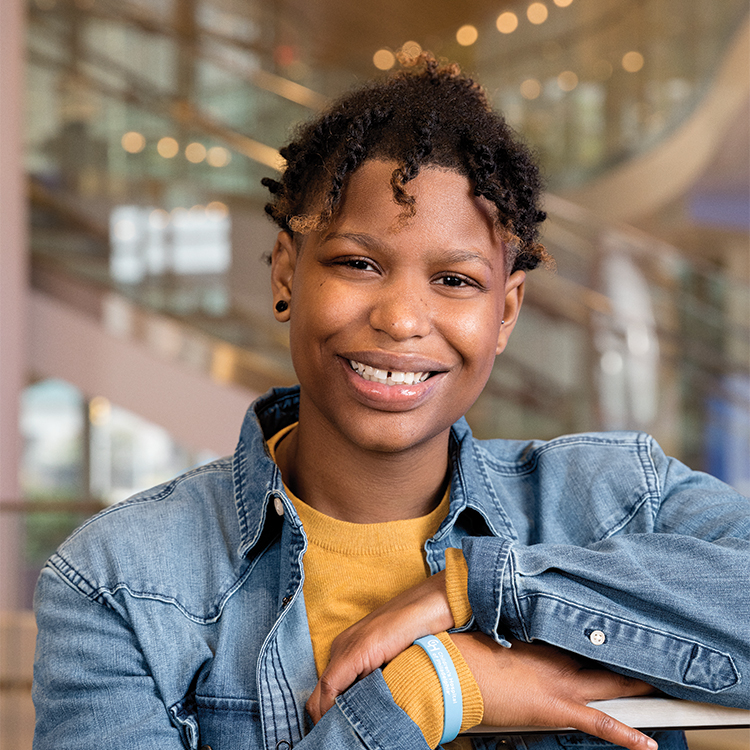
Court Simmons Photo by Colin M. Lenton
“My sister is a very determined person—stubborn sometimes, but in a good way,” says Reginald, who is now 20 and studying psychology at Drexel University in Philadelphia. He remembers tough days during Court’s treatment and recovery that slowed her down, but she persisted. “She had things she wanted to do in her life,” he says.
Along the way, the hospital began to feel like home. The nurses at CHOP became her friends, her support system and her social network. One nurse stuffed scented dryer sheets around the edges of Court’s knee brace to lessen the smell of rubber on the brace, an odor that sickened her while she was undergoing her final rounds of chemotherapy after surgery.
“They were so generous with their time,” Court says of the nurses. “They talked to me when no one else would and listened to me when no one else would, and they didn’t have to. It wasn’t in their job description.”
She missed a lot of school during treatments, but still managed to keep up with her 11th-grade classes. Sometimes, teachers would stop by the hospital after school to drop off her assignments. Other days, she would video call into class from a computer.
“My mom was so sad that she never got to see my sister graduate high school,” says Court of her older sister, Christina, who died before graduation. “It was really important to me to do that for [my mother’s] legacy.”
Court finished chemotherapy in October 2012 and returned to school for her senior year. She graduated with her high school class in June 2013.
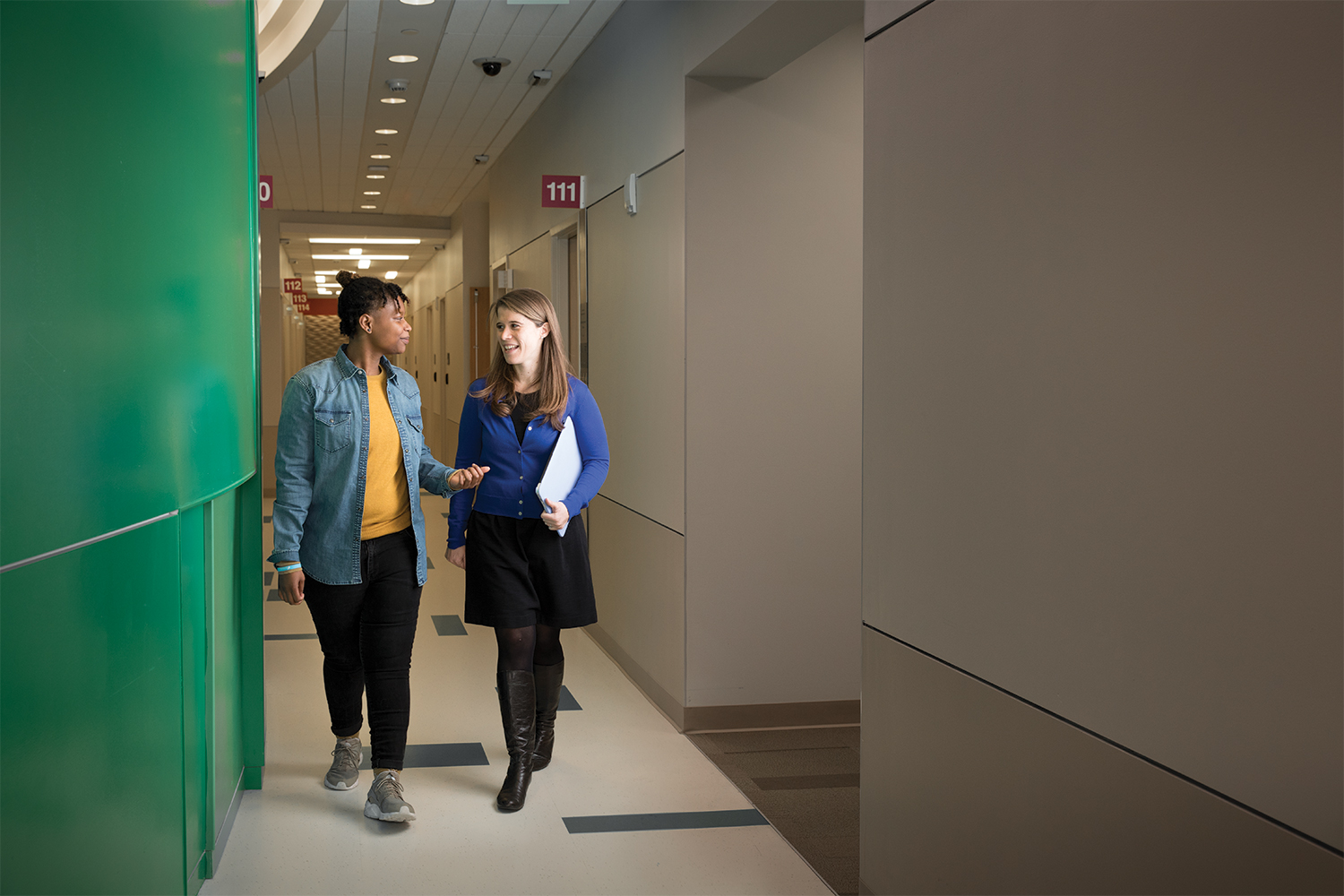
Court Simmons and her oncologist, Abby Green, at Children’s Hospital of Philadelphia Photo by Colin M. Lenton
Making Adjustments
Court won a full-tuition cancer survivor scholarship to St. Joseph’s University in Philadelphia, where she began studying interdisciplinary health services in the fall of 2013. Adjusting to college wasn’t easy at first, and she had a hard time relating to her peers.
“I just felt so lucky to be alive. Every single person I had known with cancer had died, and I didn’t,” she says. “I was a baby coming back into the real world.”
She savored the sun on her face and being able to get in and out of the bathtub by herself. Things the other college kids stressed about—getting rejected by a romantic interest or arguing with a parent—didn’t faze her. “All I could think was: I have this second chance, and I need to do something amazing,” she says.
Sitting in her sun-drenched apartment near the St. Joseph’s campus, Court, now 22, looks down at her leg and smiles. She’s come far in the past five years. The 14-inch scar that runs vertically down her left leg from thigh to shin is beginning to fade, although some days her leg still hurts. While the osteosarcoma is gone, she still thinks about cancer and the possibility it could come back. Her Li-Fraumeni diagnosis means she is at high risk of developing cancer again. Every six months, she undergoes screening for breast, bone, blood and brain cancers.
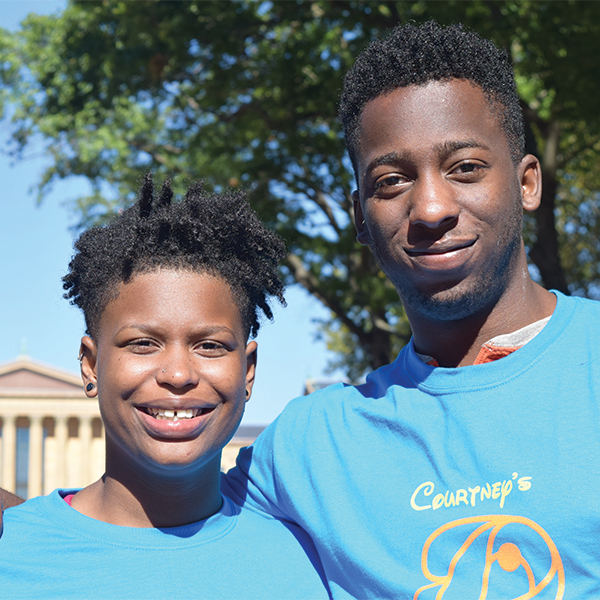
Court Simmons stands with her brother, Reginald, at the Parkway Run & Walk on Sept. 30, 2016. The annual fundraiser benefits pediatric cancer research and treatment at Children’s Hospital of Philadelphia. Photo courtesy of Court Simmons
Yet in the face of uncertainty, Court says she has found “her inner peace” by setting goals, staying focused and charting her own path. Reginald sums up his sister’s ethos: “Use the time you have wisely.”
One way she does that is by raising money to support children with cancer. She helped organize two dance marathons at St. Joseph’s to raise money for Children’s Miracle Network Hospitals and CHOP. At the inaugural dance marathon in 2016, Court and her fellow students set a goal of raising $18,510, an amount chosen to observe the year of their school’s founding, 1851. They surpassed that amount, raising $28,000 for the pediatric cancer center at CHOP. “I feel lucky to be able to give back to my hospital,” she says.
In December 2017, Court became the first person in her family to graduate from college. Now she’s working three jobs to save money and is finishing a few more prerequisite courses before applying to nursing school, one step closer to her ultimate goal—to become a pediatric oncology nurse. She wants to help children with cancer as she was once helped by the nurses at CHOP.
“A hospital can be a really unwelcoming space, but for me it wasn’t, because I was surrounded by people who made me feel safe,” Court says. “I want to do that for other kids.”
Cancer Today magazine is free to cancer patients, survivors and caregivers who live in the U.S. Subscribe here to receive four issues per year.

